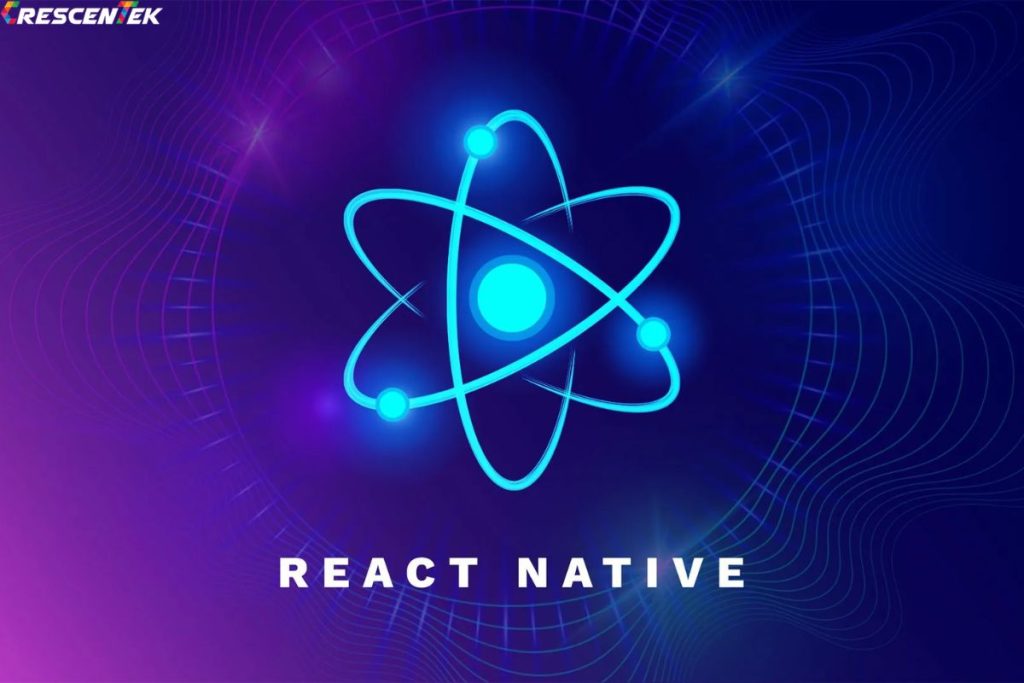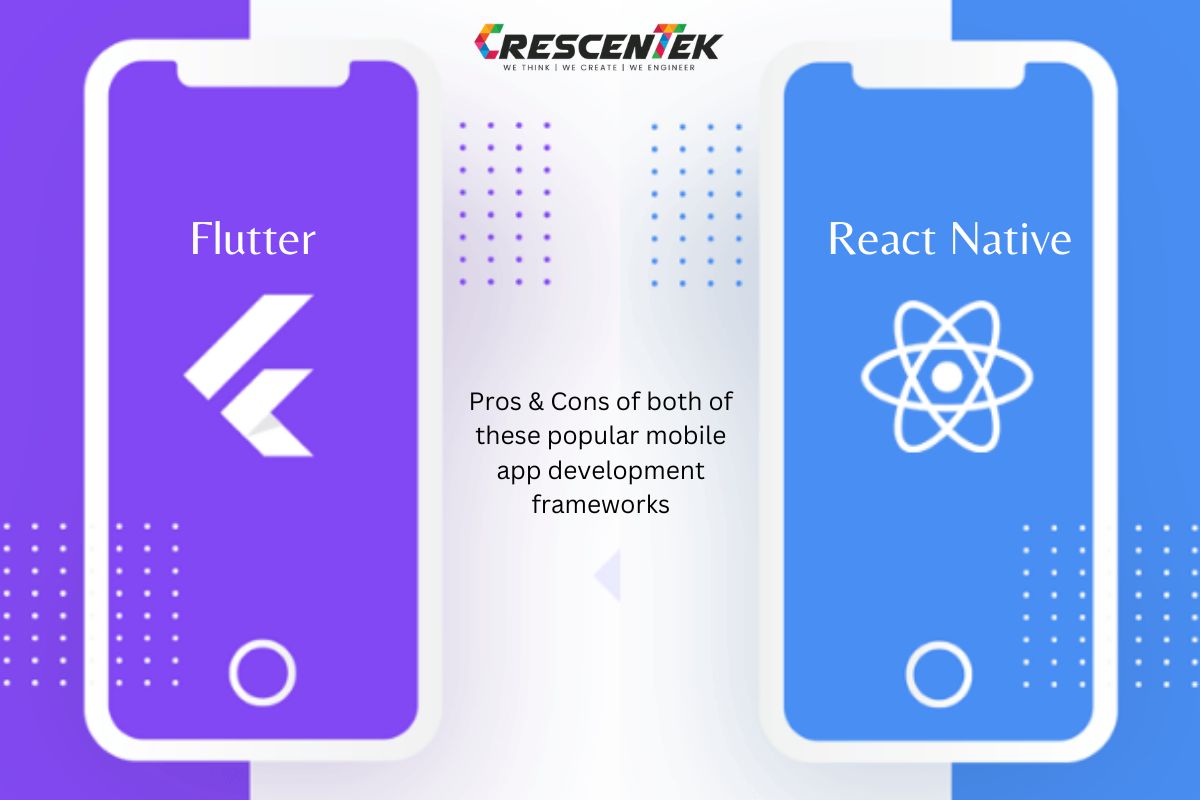- Posted On: 11 May 2023
- Posted By: Crescentek
Analysis and Comparison of the Pros and Cons of Flutter and React Native
- Home
- Post
Businesses are now looking for cost-effective and efficient ways to create high-quality mobile applications. These applications support users across various platforms in today’s quickly expanding digital ecosystem. As a popular option, cross-platform app development enables developers to create and distribute programmes for iOS, Android, and the web using a single codebase. Flutter and React Native stand out as two of the most popular and widely-used cross-platform development frameworks available.
This in-depth analysis of Flutter and React Native aims to provide you with a better understanding of the main advantages and disadvantages of each framework. This will help you decide which one best meets the needs of your particular project.
Overview of Flutter
Google developed Flutter, an open-source framework for creating natively built desktop, web, and mobile applications from a single codebase. Flutter was introduced in 2017, and since then, it has grown in popularity because of its expressive and adaptable UI capabilities, rapid development cycles, and powerful performance.
Flutter, written in the Dart programming language, employs a novel design philosophy known as “Everything is a Widget,” which enables programmers to create extremely adaptable and responsive user interfaces (UIs) by integrating a number of pre-built and bespoke widgets. Flutter has emerged as a top option for many developers and companies looking for effective cross-platform app development because of its burgeoning community, abundant documentation, and official support from Google.

The Best Features of Flutter
- A wide variety of built-in Material Design and Cupertino (iOS-inspired) widgets are available in Flutter, making it simple to design UIs that are both aesthetically pleasing and unified.
- The hot reload feature of Flutter dramatically speeds up the development process by allowing developers to see changes in real-time without losing the app’s state.
- Flutter employs a potent 2D rendering engine named Skia Graphics Engine. It quickly produces applications that are aesthetically beautiful.
- By compiling the Dart code to native ARM code, Flutter ensures the best performance on both the Android and iOS platforms.
Pros of Flutter
- High productivity: A single codebase, hot reload, and a sizable widget library all work together to increase developer productivity.
- Customizable and expressive UI: With the large selection of widgets offered by Flutter and its capacity to design bespoke UI components, developers may construct one-of-a-kind and captivating user interfaces.
- Strong support: In the fast-paced world of app development, Google’s support and ongoing upgrades make Flutter relevant and dependable.
Cons of Flutter
- Larger app size: Flutter apps often have a larger file size than React Native apps due to the presence of built-in widgets and the Skia Graphics Engine.
- The ecosystem is less developed: Despite its quick growth, React Native’s ecosystem is more developed due to the availability of more third-party packages.
- Limited native support: Although Flutter gives users access to native APIs, it is still relatively undeveloped in comparison to other frameworks, which can have an impact on your app’s functionality and performance.
Overview of React Native
React Native is a free and open-source framework created by Facebook for developing cross-platform mobile applications. React Native, which was introduced in 2015, immediately gained popularity because of its great performance, ability to make use of already-existing web development abilities, and “Learn Once, Write Anywhere” guiding principle.
With React Native, developers can create genuinely native apps with a shared codebase for both the iOS and Android platforms by using native components rather than web components. The framework has a sizable user base, substantial documentation, and is used by a lot of well-known businesses. The extensive use of JavaScript and the familiarity with React contribute to its popularity among developers and make it an appealing option for cross-platform app development.

The Best Features of React Native
- React with JavaScript: JavaScript’s widespread use and adaptability are made use of by React Native, which also benefits from the strength of the React library.
- Native components: React Native makes use of native components to provide each platform with a more genuine appearance and feel.
- Modular architecture: This feature makes it easier to update and maintain programmes and enables better developer collaboration.
Pros of React Native
- Large JavaScript ecosystem: React Native takes advantage of the large JavaScript ecosystem, which gives developers access to a variety of libraries and tools.
- Larger Support and Community: React Native has a sizable developer community, which leads to additional tools, tutorials, and third-party packages being made accessible for use.
- Code reuse: By reusing a large amount of the code across platforms, developers can cut expenses and development time.
Cons of React Native
- Limitations in the performance: React Native’s reliance on a JavaScript bridge to interface with native modules might occasionally result in decreased performance, making it a poor fit for high-performance apps.
- It needs native platform knowledge: Native platform knowledge is required, which can be a hurdle for individuals who are not familiar with iOS or Android programming. This knowledge is necessary to optimise the user experience.
Performance Comparison Of Flutter And React Native
When selecting a cross-platform framework, performance is an important factor to take into account because it directly affects the user experience and overall quality of the project. Both Flutter and React Native offer high performance. However, they use different approaches, which may have an impact on the final product depending on the needs of your project.
The Dart programming language, which is translated into native machine code, is used by Flutter. High-performance applications with fluid animations and transitions are its outcome. Furthermore, Flutter’s original method of utilising the graphics engine Skia for rendering enables it to consistently deliver 60 FPS (frames per second) across platforms. This guarantees a responsive and smooth user experience that is frequently on par with native apps.
On the other hand, React Native uses JavaScript to create cross-platform applications. Because JavaScript is an interpreted language, performance may be a little bit slower than with native code. However, React Native uses the JavaScript Bridge to interact with native components, producing a better-than-native user experience. Although React Native’s performance is usually regarded as good, in some situations—especially those involving sophisticated animations or large datasets—it might fall short of Flutter’s speed.
It’s crucial to remember that for the majority of scenarios, the performance difference between Flutter and React Native may not be noticeable. However, because of its native compilation and effective rendering capabilities, Flutter may be the best option for applications with high-performance demands or where smooth animations are crucial.
Consult A Professional To Know Your Needs Before You Hire A Mobile App Developer
Mobile app development is a very enjoyable and rewarding experience, but only when you know your tech stack well. Seek professional help when deciding which option is best for you, on par with market trends and future-centric solutions. Consulting a professional doesn’t mean that you must hire them, but when you are looking to hire a Flutter developer or React Native developer, you must have a winning plan, where your cost and time are put into the right resources.
